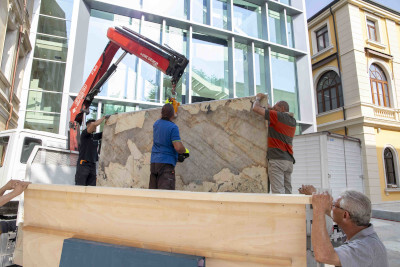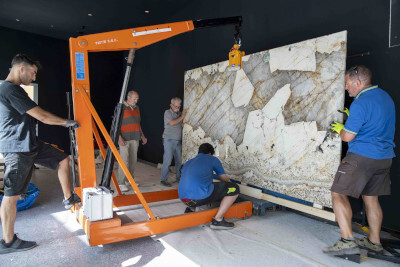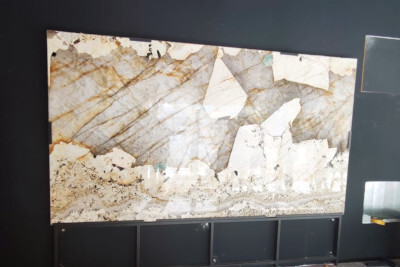The donation of the slab Patagonia from our warehouse for the opening of the "Museum of Nature and Humans" at Palazzo Cavalli in Padua
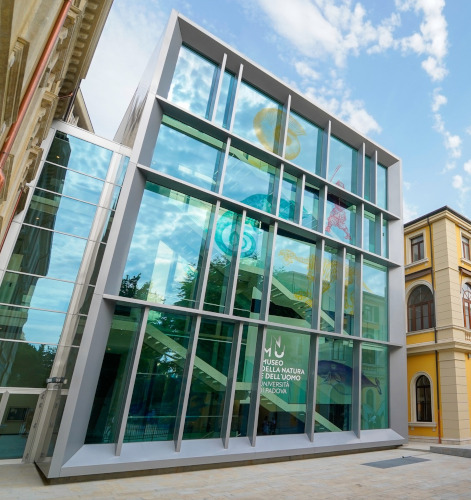
On Friday, June 23, 2023, Palazzo Cavalli in Padua hosted the inauguration of the Museum of Nature and Humans, the largest university museum in Europe and an important permanent legacy for the city which celebrates the eight hundredth anniversary of the University of Padua.
On the opening day, the Rector of the University Daniela Mapelli, the Scientific Director of the Museum and delegate of communications and scientific publication Telmo Pievani and the President of the University Museum Centre Fabrizio Nestola attended the inauguration ceremony that was live streamed (visible here) and which began with the cutting of the inauguration ribbon.
The event was attended by two female and two male directors of international museums, including Katrin Vohland of the Natural History Museum Vienna (Austria), Jeffrey Post of the National Museum of Natural History, Smithsonian Institution, Washington D.C. (USA), Analía A. Lanteri of the Museo La Plata, Paseo del Bosque (Argentina) and Ken-ichi Shinoda of the National Museum of Nature and Science, Tokyo (Japan), who exchanged their experiences.
The museum, designed by the architects Guicciardini & Magni Architetti, exhibits more than 3,700 historical treasures, of which over 3,200 were restored for the museum's opening, reconstructions, flashcards and 90 interactive multimedia contributions.
In addition to several attractive exhibition rooms and a large selection of collections (more than 200,000) from the fields of mineralogy, geology and palaeontology, zoology and anthropology, one can admire the beautiful granite slab Patagonia from Marmi Rossi’s warehouse of Cavaion V.se.
The company Marmi Rossi as a donor is proud to have been involved in the implementation of the museum project in Padua.
Set up of the slab Patagonia in the Museum of Nature and Humans (photos from Federico Milanesi of Unipd and Valeria Rossi)
Thanks to the long-standing relationship with Prof. Bernardo Cesare, Professor of Petrology and Petrography at the Institute of Geology of the University of Padua, we got the possibility to participate in this museum project.

This very important event gives Padua prestige and, as we really feel close to the subject of Geology, we’ve decided to collaborate with the University by participating in the project, as donors of the splendid granite slab Patagonia (Pegmatite and Aquamarine, origin Brazil).
At the inauguration of the Museum of Padua, we also commemorated Maurizio Rossi, founder of Marmi Rossi, with a memorial plate for him, who was not only a lover of culture, but had a great admiration for Saint Anthony of Padua, too.
Next to the granite slab, we have had installed a commemorative plate with the dedication "In memory of the founder Maurizio Rossi (1916-1998)".
Claudio Rossi, who was present at the set-up of the slab in the museum and attended the opening ceremony, shares his impressions with us:
"First of all, I must confess that our company and I are personally proud to have made a contribution to this sensational museum with our donation: an opportunity to remember our father Maurizio and Professor Guistoni, who died dramatically a few months ago and who was particularly fond of this slab, considering this type of special granite with pegmatites as a real lesson about the world.
Back to the museum: it is not the classic museum as we are used to. Here at the Museum of Nature and Humans, one can interact with the elements on display and a series of exciting multimedia installations which will captivate visitors of all ages.
From the entrance along the corridor to the exhibition rooms, it seems to walk in space between stars and planets, until one arrives at a large, round and initially dark room; there one has the feeling of being in the primordial core of the earth, from which one rises to the surface.I really liked the display cases with the gemstones and semi-precious stones, which we can also find inside pegmatites, such as Patagonia, where two large aquamarines are clearly visible.
The showcases with pieces of marble, used in antiquity, as well as the collections of minerals from Veneto, Italy and all over the world, are also astonishing.
The other areas of the museum impressed me with skeletons of prehistoric animals, especially the sabre-toothed tiger, but also the foundations of the pile dwellings of Lake Ledro, not to mention the large wooden canoes or the collection of Australian boomerangs were most impressive.
It is difficult to describe everything in detail because it would take too long and you always end up forgetting something, such as the marine room or the room dedicated to the fossils of Bolca.
The collection of found objects is also interesting and well thought out, it is partly housed in the magnificent Palazzo Cavalli, a stately residence from the 16th century of opulent architectural style and with many frescoes that were added during the following centuries.
Although I have anticipated some things, I would like to invite everyone to visit this magnificent museum, especially since it is home to the University of Padua, which has just celebrated its eight hundredth anniversary, proving with this museum once again why the University Centre of Padua is still at the top of Italian universities."
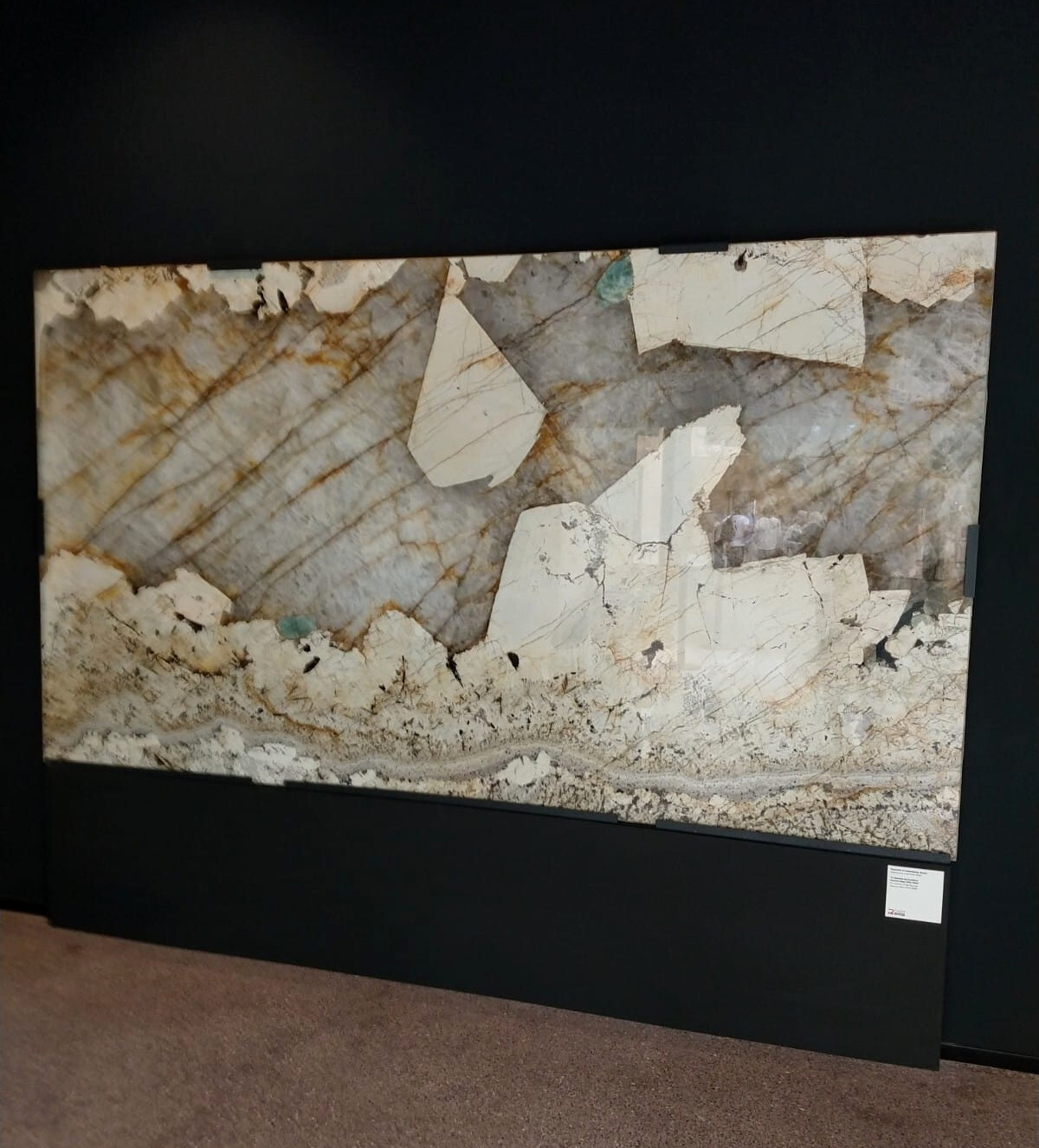 Exhibition of the pegmatite in the Museum of Nature and Humans with commemorative plaque for Maurizio Rossi
Exhibition of the pegmatite in the Museum of Nature and Humans with commemorative plaque for Maurizio Rossi

